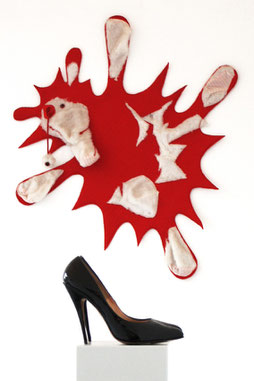KUNSTENAAR IN ATELIER

Since 1993 Maas has photographed himself at the various addresses where he has been in labor ever since artschool graduation. The portfolio can be considered as an artist resume and balances against other succesful artists biographies displayed in the media. The motive prior to this project has been a recurring inspiration for his artistic work ever since.
Maas graduated artschool in 1990. Although there wasn't an overall national system for young graduated artists, they could count on financial support by the government - depending on the municipal policy where they lived - to develop their profession.
Soon after his graduation, the municipality where Maas used to live ignored his status as a graduated artist and they decided that Maas had to find himself a job. Without any scholarship or financial support Maas went looking for a way to become self-supporting while making art in his studio. Initially, to maintain his status he prefered to find himself a part-time (unskilled) job rather than a creative full time contract or assignments. Soon he found himself between 2 worlds, the artist opposite the laborer. The new artistic life wasn't what he'd expected to be while studying art and the standards set up by the art world to comply with the artistic practice where hard to accomplish in his new situation.
From that moment He's been fathoming the myth of 'being an artist'. While getting a grip on his own artistic situation, his artistic career became more like a hobby to others.

The photo series that emerged indicate his dissatisfaction with the situation and is entitled 'kunstenaar in atelier' (artist in studio) .
In 1993 Maas started to photograph himself at the various addresses where he has been in paid employment ever since graduation. He is portraying himself standing on high heels; a reference to masculinity, Masculinity and identity still are two major themes in Maas' works. In fact the standards set for 'masculinity' are like the standards set for 'being an artist', they are based on agreements within a community, they depend on time and place.
Through the years less accent was given to the feminine shoes and fetish elements. In 2013 Maas designed his own individual shoes out of 3 pair of worn work shoes. It seemed that he has found his own unique way to maintain his artistic practise.

The provocative photographic testimonials are in sharp contrast to the many successful but often over-valued references within an artist curriculum vitae and show us the hidden side of the artistic practice: to work as an employee, which is what most graduated artists have to deal with. The design of his new artistic life based on standards appropriate to his own situation while criticizing the demands and standards set by the artworld, still is a dominant theme in the works of Maas. Such example is the Lucky Star Gallery that originated in 2014.
The portfolio is the centrepiece of 'Have a new life - for the artist'. Maas devised one project-title under which he could present all new developments.
Besides artist in studio 'Have a new life for the artist' covers commercial works which emerged from his own initiative or as a result of an assignment. Some commercial works/projects are directly derived from his independent works or remain content- related to them like Babelle , Not in my garden and Bstyle
In July 2011 Maas wrote a manifest that was published in NRC-next and Brabants Dagblad, two Dutch newspapers, in response to the debate about culture financial cuts. While victims complained and feared the end of the arts, Maas hoped to encourage them by commenting upon the situation from his (non-subsidised) point of view, which in fact has proven the contrary.